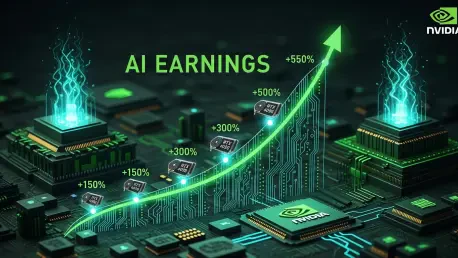In a landscape where artificial intelligence continues to reshape industries at an unprecedented pace, Nvidia Corporation has emerged as a titan, driving innovation with its latest financial performance. The company’s third-quarter earnings report, unveiled on November 19, not only surpassed Wall Street expectations but also sent shockwaves through the tech sector, underscoring the insatiable demand for AI technologies. With earnings per share of $1.30 against a forecast of $1.26 and revenue hitting $57.01 billion compared to an expected $55.2 billion, Nvidia has demonstrated its pivotal role in powering the AI revolution. This remarkable achievement, coupled with a projected fourth-quarter revenue of $65 billion, paints a picture of sustained growth that extends far beyond a single company. It signals a broader trend of investment and enthusiasm for AI, positioning Nvidia as a bellwether for the industry’s future trajectory.
Unpacking Nvidia’s Financial Triumph
Stellar Revenue and Earnings Growth
Nvidia’s third-quarter results have set a new benchmark for success in the semiconductor and AI sectors, reflecting a year-over-year leap that few could have anticipated. The company’s revenue soared to $57.01 billion, a significant jump from the $35.1 billion recorded in the same quarter of the prior year, while earnings per share climbed to $1.30 from $0.81. A key driver behind this surge was the data center business, which alone generated $51.2 billion, outpacing estimates of $49.3 billion. This segment’s performance highlights the critical role of AI infrastructure in modern tech ecosystems. Although gaming revenue slightly underperformed at $4.3 billion against a forecast of $4.4 billion, the overall financial picture remains overwhelmingly positive. The projected revenue for the next quarter, estimated at $65 billion, further cements confidence in Nvidia’s ability to meet and exceed market demands, driven by a relentless focus on AI innovation.
The Blackwell Architecture Phenomenon
Central to Nvidia’s financial success is the overwhelming demand for its AI-related products, particularly the Blackwell architecture, which has become a cornerstone of the company’s offerings. CEO Jensen Huang’s assertion that Blackwell sales are “off the charts” reflects a market where cloud GPUs are completely sold out, indicative of a booming AI ecosystem. This architecture, alongside the newly introduced Blackwell Ultra, is leading across customer segments, while demand for the prior version remains robust. The adoption of AI technologies across diverse industries, startups, and even entire countries has created a self-reinforcing cycle of innovation and need. Notably, revenue from region-specific products like the ##0 chip for China was deemed insignificant, suggesting that Nvidia’s growth is primarily fueled by global rather than localized markets. This widespread embrace of AI solutions underscores how Nvidia’s technological advancements are not just meeting current needs but also shaping future expectations.
Broader Impacts on the AI and Tech Landscape
Ripple Effects on Industry Stocks
The reverberations of Nvidia’s earnings report were felt far beyond its own balance sheet, as the tech sector experienced a collective uplift in stock performance following the announcement. Nvidia’s shares surged over 5% in after-hours trading, a clear signal of investor confidence in its growth trajectory. This momentum spilled over to other players in the AI space, with Advanced Micro Devices seeing a nearly 4% increase in its stock value, while Micron gained over 3%. Major tech giants such as Amazon, Google, Meta, and Microsoft also recorded slight upticks, reflecting shared optimism about AI’s potential. This interconnected rise suggests that Nvidia’s success is not an isolated phenomenon but rather a marker of a thriving industry where advancements in one company can catalyze growth across the board. The market’s response illustrates a consensus that AI technologies are a cornerstone of future economic value.
Market Trends and Critical Perspectives
While Nvidia’s performance paints a rosy picture for the AI industry, it also exists within a complex web of market dynamics and critical viewpoints that warrant attention. The company’s stock has risen 37% year-to-date, with competitor Advanced Micro Devices outpacing it at an 82% increase over the same period, highlighting fierce competition and investor interest in the sector. However, significant divestitures by major stakeholders, such as Peter Thiel’s hedge fund and SoftBank Group offloading holdings worth $100 million and $5.8 billion respectively, indicate a strategic shift toward diversifying AI investments. Meanwhile, skepticism from notable investor Michael Burry, who questions the accounting practices of some AI firms, introduces a note of caution. Despite projections like AMD CEO Lisa Su’s estimate of the data center market reaching $1 trillion by 2030, such dissenting voices remind the industry to balance enthusiasm with scrutiny. These contrasting perspectives shape a nuanced narrative around Nvidia’s earnings, reflecting both opportunity and caution in equal measure.









